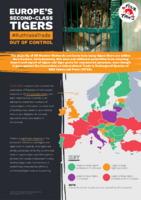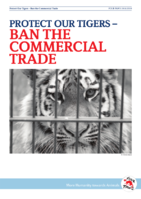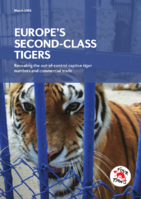
‘Europe’s second-class tigers’
A FOUR PAWS report documenting the out of control number of captive tigers in Europe and subsequent commercial trade
While the EU takes a leading role at international level in combatting wildlife trafficking and even funds initiatives to tackle illegal wildlife trade, it continues to face a lack of effective regulation concerning the trade and the use of tigers for commercial businesses within its own territory.
Without effective record-keeping of captive tiger numbers in EU member states and control on the trade within the EU, cases of illegal trade will continue to flourish.
Note: Any advertisements that may appear during the viewing of this video are unrelated to FOUR PAWS. We assume no liability for this content.
Addressing the problem
FOUR PAWS set itself the task to contact authorities in 28 member states and 8 neighbouring countries and find out, through Freedom of Information requests, how many captive tigers are kept in Europe (in zoos, circuses, private keeping, rescue centers). A total of 641 authorities (national/regional/ local) were contacted during that period by FOUR PAWS (e.g. in the UK 410 authorities had to be contacted to receive the numbers).
Nineteen countries (including 15 member states) were unable to share how many tigers are kept in captivity. Unfortunately, this does not withhold authorities from allowing commercial trade in tigers and tiger products to continue, as illustrated in this report, including data on trade from the CITES database between 2014-2018.
The acceptance of a widespread commercial trade in (largely unregistered) captive tigers renders the captive-born tiger a ‘second-class tiger’ as it is not offered the same protection as wild tigers.
Read the full report here:
The EU should take proper action as part of the European Commission's EU Action Plan against Wildlife Trafficking (EU WTAP) to which it signed up in 2016. Ending the commercial trade in tigers would be an essential and much-needed move.
Read the brochure with key figures here:

#RuthlessTrade Out of Control
The majority of EU Member States do not know how many tigers there are within their borders. Unfortunately, this does not withhold authorities from allowing import and export of tigers and tiger parts for commercial purposes, even though it goes against the Convention on International Trade in Endangered Species of Wild Fauna and Flora (CITES).
Read our first report on tiger trade: Protect Our Tigers – Ban the Commercial Trade

Protect Our Tigers – Ban the Commercial Trade
With only 3,140 tigers left in the wild it seems clear that there should be no commercial trade whatsoever in these animals or their parts. Unfortunately, the reality is that the relentless demand for tigers to be displayed commercially and their body parts to be used for luxury goods and traditional medicine has meant they are in fact traded in vast numbers within the EU and across the globe.


